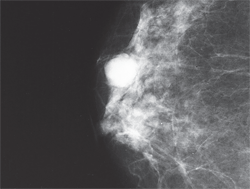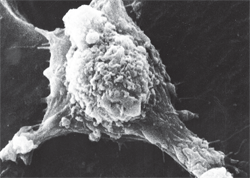 The American Cancer Society defines cancer (or carcinoma) as a group of diseases characterized by uncontrolled growth and spread of abnormal cells. Cancer has the capacity to invade surrounding normal tissue, metastasize, and kill the host in which it originates. Neoplasia (neo=new, plasia=tissue) is the process of abnormal growth that starts from a single altered cell.1
The American Cancer Society defines cancer (or carcinoma) as a group of diseases characterized by uncontrolled growth and spread of abnormal cells. Cancer has the capacity to invade surrounding normal tissue, metastasize, and kill the host in which it originates. Neoplasia (neo=new, plasia=tissue) is the process of abnormal growth that starts from a single altered cell.1
Cancer is responsible for about 25% of all deaths in the United States; it is the second most common cause of death (behind heart disease). Although the incidence of cancer is decreasing in both men and women, an estimated 1,479,350 new cases of cancer were diagnosed in 2009.2 In the U.S., cancer is the leading cause of death by disease in children younger than age 15.1,2 (See “The Most Common Cancers.”)
The Most Common Cancers
The five leading sites of new cancer cases in the United States in males and females (all races) 2009.2
Rank
Males
Female
1
2
3
4
5
Prostate
Lung/Bronchus
Colon/Rectum
Urinary bladder
Skin melanoma
Breast
Lung/Bronchus
Colon/Rectum
Uterine corpus
Non-Hodgkin’s lymphoma
Benign vs. Malignant Neoplasms
A neoplasm may be benign or malignant. Benign neoplasms cannot spread by invasion or metastasis; they only grow locally. Malignant neoplasms are capable of spreading by invasion and metastasis. By definition, the term “cancer” applies only to malignant tumors.1,3
The most critical criterion in differentiating benign from malignant tumors is biological activity, specifically invasion and metastasis. Both invasive destruction and metastasis occur in malignancies––not in benign cases. In general, neoplastic cells must first develop the capacity to invade before they can metastasize.3
Metastasis may occur in several ways. It can result from spread into body cavities, which involves direct “seeding” of serous membranes. Another route of metastasis is by lymphogenous spread, in which cells travel through the lymphatic system to nearby or distant nodes. Metastasis may also occur by hematogenous spread, in which cells travel through the bloodstream. A less common route of metastasis is by implantation or inoculation. This can occur when a biopsy or surgical procedure is performed. Malignant cells may actually drip from a needle or an instrument and become implanted into new tissue.1,3,4


A mammogram with a whitish area that was diagnosed as ductal carcinoma. About one in every seven women in the United States will develop breast cancer over a 90-year life span.
Cancer cells grow “arms” or pseudopodia, enabling them to migrate to other parts of the body. Locomotion is integral to the entire process of metastasis.
Cellular Basis for Neoplasia
The reproduction of normal, healthy cells is by division, which occurs throughout the body in a regulated and systematic fashion throughout life. Depleted or injured cells must be replaced and certain cells must increase in number and activity in response to environmental changes. In cancer, however, the division of cells occurs in a haphazard manner, leading to uncontrolled growth and possible spread.4
The growth, inheritance and containment of a cell is controlled by its DNA. The number of human protein-coding genes is estimated to be 20,000 to 25,000.5 Cells divide only when they receive the proper growth factor signal, either from the blood stream or from an adjacent cell. Once a cell receives the signal to divide, it goes through the “cell cycle.” If a defect occurs during this complicated process, a cell may become cancerous.4
In a cancer cell, several genes may mutate. Some of these, called oncogenes, stimulate cell division. These cancer-promoting oncogenes give the cell new properties, including hyperactive growth/division and protection against programmed cell death. Other genes, called tumor-suppressor genes, slow cell division. In the normal state, both types of genes work together to replace dead or repair damaged cells.4
Mutations in these genes cause cells to proliferate out of control. Such mutations can be inherited or acquired through environmental causes. A cell can become abnormal when part of the gene is lost (deleted), part of the chromosome is rearranged (translocation), or when a small defect occurs in the DNA and a defective protein results.4
Angiogenesis and Neoplasia
An important mediator of neoplastic growth is blood supply. To grow beyond 1mm to 2mm in diameter, a neoplasm must become vascularized. Neovascularization supplies nutrients and oxygen. Newly formed capillary endothelial cells stimulate neoplastic cell growth by secreting polypeptide growth factors, such as interleukin-1 (IL-1), platelet-derived growth factor (PDGF) and insulin-like growth factor.4,6
Some research has demonstrated a correlation between the extent of angiogenesis and the probability of metastasis. Neoplasms contain endogenous factors capable of driving the process of angiogenesis. Two of the most important are vascular endothelial growth factor (VEGF) and basic fibroblast growth factor (bFGF). Both are commonly elevated in a wide variety of different types of neoplasms.4,6
In summary, all multicellular organisms have the potential to develop cancer. A neoplasm is an abnormal mass of tissue that results when cells divide more than they should or do not die when they should. Neoplasms may be benign or malignant, depending on their biological activity.
Cancer has environmental, chemical, cellular and genetic causes, with the host genetic composition and immunobiological status contributing to the process.
Next: Neoplastic Disease, Part II.
1. National Cancer Institute. Cancer Registration & Surveillance Modules: Cancer As a Disease. http://training.seer.cancer.gov/disease/ (accessed August 19, 2010).
2. American Cancer Society. Cancer Facts & Figures 2009. Atlanta: American Cancer Society; 2009.
3. Cornett PA, Dea TO. Cancer. In: SJ McPhee, MA Papadakis, eds. 2010 Current Medical Diagnosis and Treatment. 49th ed. New York: McGraw Hill Medical; 2009:1450-1511.
4. Weinberg RA. The Biology of Cancer. New York: Garland Science; 2006:ch.1-5.
5. Stein LD. Human genome: end of the beginning. Nature. 2004 Oct 21;431(7011):915-6.
6. Rao VU, Shenoy AM, Karthikeyan B. Role of angiogenetic markers to predict neck node metastasis in head and neck cancers. J Cancer Res Ther. 2010 Apr-Jun;6(2):142-7.

